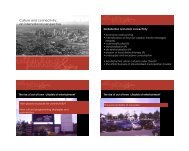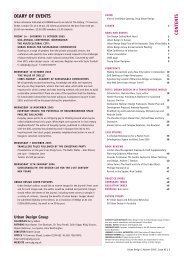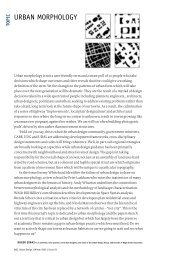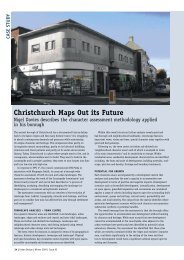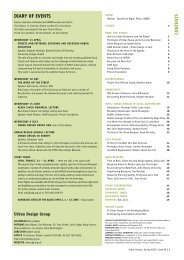topic - urban-design-group.org.uk
topic - urban-design-group.org.uk
topic - urban-design-group.org.uk
Create successful ePaper yourself
Turn your PDF publications into a flip-book with our unique Google optimized e-Paper software.
TOPIC<br />
THE HOUSING MARKET RENEWAL PROCESS<br />
Jim Chapman draws some conclusions from EDAW’s experience<br />
the ‘sharing philosophy’, being promoted<br />
by CABE and EP.<br />
There is a need for Local Strategic<br />
Partnerships to take ownership and<br />
commit to delivering programmes on<br />
a whole range of issues - not just the<br />
physical components. The partnerships<br />
must not become talking shops.<br />
Consultation to be effective must result<br />
in action.<br />
The importance of place can not<br />
be over emphasised. Which cities and<br />
towns should grow and which should<br />
shrink? It is important to stress identity<br />
and offer the individual choice. There<br />
is significant experience of the impact<br />
of major regeneration on re-structuring<br />
communities and decanting people<br />
within individual neighbourhoods.<br />
This information must be used with<br />
great care to consider migration and<br />
modes of travel. The debate in the House<br />
of Commons recently on a ten year<br />
transport strategy raised the importance<br />
and the sensitivity of these issues, and<br />
focuses on the need for long term robust<br />
planning approaches.<br />
The nine Housing Pathfinders announced in April 2002 were<br />
established to tackle identified areas of low demand covering<br />
some 700,000 homes. EDAW has been closely involved with the<br />
development of proposals for five of the nine pathfinder areas<br />
in Birmingham Sandwell, Manchester Salford, Merseyside, East<br />
Lancashire, Hull and the East Riding of Yorkshire.<br />
SHARING EXPERIENCES<br />
Because of a lack of joined up policy within central, regional<br />
and local government, some authorities have made significant<br />
changes to their management structures integrating departments<br />
to form motivated and knowledgeable regeneration teams to<br />
respond to the programme and implement the new planning<br />
procedures.<br />
Who is the driving force for physical regeneration? Is it<br />
Government Offices, the Regional Development Agencies,<br />
English Partnerships, or CABE? All these <strong>org</strong>anisations provide<br />
a plethora of well thought out strategies and <strong>design</strong> guidance.<br />
Teams are inundated daily with advice on all aspects of good<br />
practice. How do teams assimilate, respond and use this<br />
information. How do we ensure feedback not only for ourselves<br />
but into the ongoing pathfinder programmes? In our work in<br />
the Wirral, Sandwell and Sefton areas we have worked closely<br />
with the planners and <strong>urban</strong> <strong>design</strong>ers to develop and establish<br />
quality standards, preparing frameworks to enable the ongoing<br />
developments. This work continues and is a fundamental part of<br />
MAJOR ISSUES<br />
The major problems we face in this<br />
massive and important programme<br />
include:<br />
• macro economic factors<br />
• backlog of terrace clearance from 1970s<br />
• concentration of low income and social<br />
problems<br />
• housing management issues and surplus<br />
council stock<br />
• sub-<strong>urban</strong>isation of the city, fracturing<br />
effects and failure to address social<br />
problems,<br />
• loss of identity and lack of investment<br />
in quality of environment in<br />
neighbourhoods<br />
• in some areas planning policies still<br />
favouring flight to the suburbs.<br />
A range of measures from clearance<br />
to environmental improvements,<br />
refurbishment, and new development<br />
has been proposed for many areas.<br />
The objective for all the proposals is<br />
to firstly understand and establish the<br />
particular issues for the area concerned<br />
and endeavour to direct the market in<br />
these areas to a more sustainable position,<br />
removing their reliance upon public<br />
funding for survival and encouraging a<br />
situation in which private investment<br />
and maintenance is the norm.<br />
Despite an initial perception from<br />
most parties involved that ‘more radical’<br />
32 | Urban Design | Autumn 2004 | Issue 92



